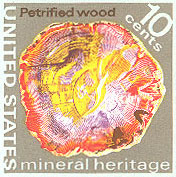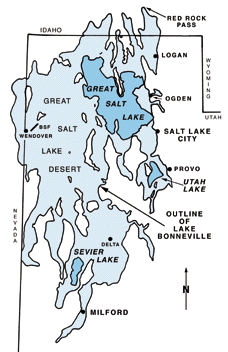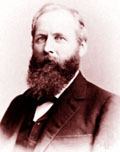
|
History of Geology |

Born: 6 May 1843, Rochester, New York.
Died: 1 May 1918, Jackson, Michigan.
| Abstract | Introduction |
| Major works | Later life |
| Historical assessment |

|
History of Geology |

Born: 6 May 1843, Rochester, New York.
Died: 1 May 1918, Jackson, Michigan.
| Abstract | Introduction |
| Major works | Later life |
| Historical assessment |
Gilbert worked mainly in Utah under Wheeler and Powell, where he made astute observations concerning geomorphology, stratigraphy, and structural geology of the Great Basin region. He recognized two types of mountain building—fault-block uplift and laccolith doming. He also named ancient Lake Bonneville, whose raised shorelines he used to demonstrate crustal isostasy. In 1879, he joined the new USGS and continued Lake Bonneville field work under King.
The second stage of Gilbert's career began in 1881 when Powell became USGS director and Gilbert was transferred to Washington, D.C. Most of the next two decades he spent as a geologist-bureaucrat overseeing, editing, and directing the work of others. He suffered great personal losses when his first daughter died in 1883 and his invalid wife died in 1899. He became a highly respected geologist and received prestigious awards. Meanwhile, his geological contributions were declining as administrative duties took more and more of his time. Finally in 1905, he had a last opportunity to study hydraulic mining and the Sacramento River in California. His reports on fluvial geomorphology based on this work were among his best.
Gilbert's father was an artist in Rochester, New York. He finished high school there in 1858
and graduated from the University of Rochester in 1862, where he had traditional training in
the classics. Henry A. Ward, of Ward's Scientific Establishment, was his instructor for
zoology and geology. After one year of teaching in Jackson, Michigan, Gilbert returned to
Wards, where he spent five years as an assistant. He sorted, named, and labelled thousands of
specimens. This was his geological apprenticeship; it was practical, though dull, training.
Gilbert volunteered for the Ohio Geological Survey under Newberry (1868-70). He mapped glacial
moraines and raised beaches of Maumee Valley in the Lake Erie basin. In 1871-74, he served
with the Wheeler Survey of Nevada-Arizona Great Basin topography. He recognized the tectonic
origin of "fault-block" mountains. He was unhappy with refusal of his request to publish some
geological findings, so he terminated his work with Wheeler. In 1874, he married Fannie Porter.
By this point in his life, Gilbert had become a seasoned field geologist with wide-ranging
experiences.
Taken from Utah Geological Survey, Public Information Series—see Lake Bonneville.
As Chief Geologist, Gilbert spent most of his time editing reports and maps, and he became a confidante and right-hand man to
Powell. This allowed no chance for field work of his own. Powell had great ambitions for
western settlement. The key was topographic mapping and irrigation development. As a result,
Gilbert finally was put in the field again to study artesian water of Colorado, beginning in
1893 through 1895. Meanwhile, Powell resigned under controversy and lacking political support
in 1894.
His last great chance came in 1905, when he was sent to California in connection with hydraulic
gold mining. He studied the fluvial character of the Sacramento River and impact of mining
debris. He conducted the first major quantitative modeling of streamflow in large flumes,
and observed the effects of the great 1906 earthquake in San Francisco. His work in California
was some of his finest, and his reports on hydraulic mining were masterpieces of engineering geology.
Between trips to California, he worked on Niagara Falls vicinity (near Rochester, NY). Gilbert suffered a stroke in 1909,
which greatly slowed him for a few years. In 1918, at age 74 and still active in the field,
he made plans to marry again to Alice Eastwood, a California botanist. The plans were never
realized, as his health collapsed and he died five days before his 75th birthday.
Return to history of geology syllabus or schedule.Introduction
Gilbert was an American geomorphologist, stratigrapher, structural geologist, and cartographer.
He was a charter member of the U.S. Geological Survey and was twice President of the Geological
Society of America. He made fundamental contributions on methods of mountain building, history
of Lake Bonneville, glacial geology of the Great Lakes and Alaska, and hydraulic mining in
California.Major works of Gilbert
Gilbert joined the Powell Survey of the Great Basin region, mainly in Utah (1874-79). He
recognized the intrusive origin of the Henry Mountains, which he called "laccolites" (later
laccoliths). He named "Lake Bonneville" in 1875 after army capitan Benjamin L.E. de
Bonneville, who had earlier explored the region. This was a giant Pleistocene lake, which
he continued to study for several years.

The western surveys were unified under the U.S. Geological Survey (USGS)
in 1879. Gilbert was appointed a charter member with Clarence R. King as the first director. King placed Gilbert
in charge of the Great Basin Division, and Gilbert immediately set about more field work in
the Lake Bonneville vicinity. In 1881, John Wesley Powell became the second director of the
USGS, and he promptly transferred Gilbert to a Washington, D.C. desk job. Ten years ellapsed
before Lake Bonneville finally was published as USGS Monograph 1 (1890).

Photo by JSA.

Meteorite Crater Natural Landmark, northeastern Arizona. Views from the rim showing upturned sedimentary strata of the Colorado Plateau. The crater is nearly circular and about 4000 feet (~1.2 km) across. See Meteor Crater. Photos by JSA.


Portrait of the American geologist G.K. Gilbert (1843-1918), picture taken around 1885. In the public domain; obtained from Wikimedia Commons.
Later life of Gilbert
For nearly two decades, Gilbert had little opportunity for field work. His loyalty to Powell
and the USGS came to dominate his life. However, he did not like nor was he well suited to the
"administrivia" of his position. Still, he did have great influence with younger geologists,
and he became highly respected as his publications came out. By the early 1900s, his original
geological contributions had mostly ended.Historical assessment
Gilbert served 39 years with the U.S. Geological Survey, from 1879 until his death. The
USGS career brought both rewards and penalties. The USGS provided support for his work in
the western United States, which is still regarded highly. However, administration prevented
continued western field work; Gilbert always felt more comfortable in the field than behind a
desk in Washington, D.C. Nonetheless, he helped to make the USGS a respected scientific
institution. Without doubt Gilbert was one of the finest field geologists and administrators
of his day. He was a "great engine of research."
© J.S. Aber (2023).